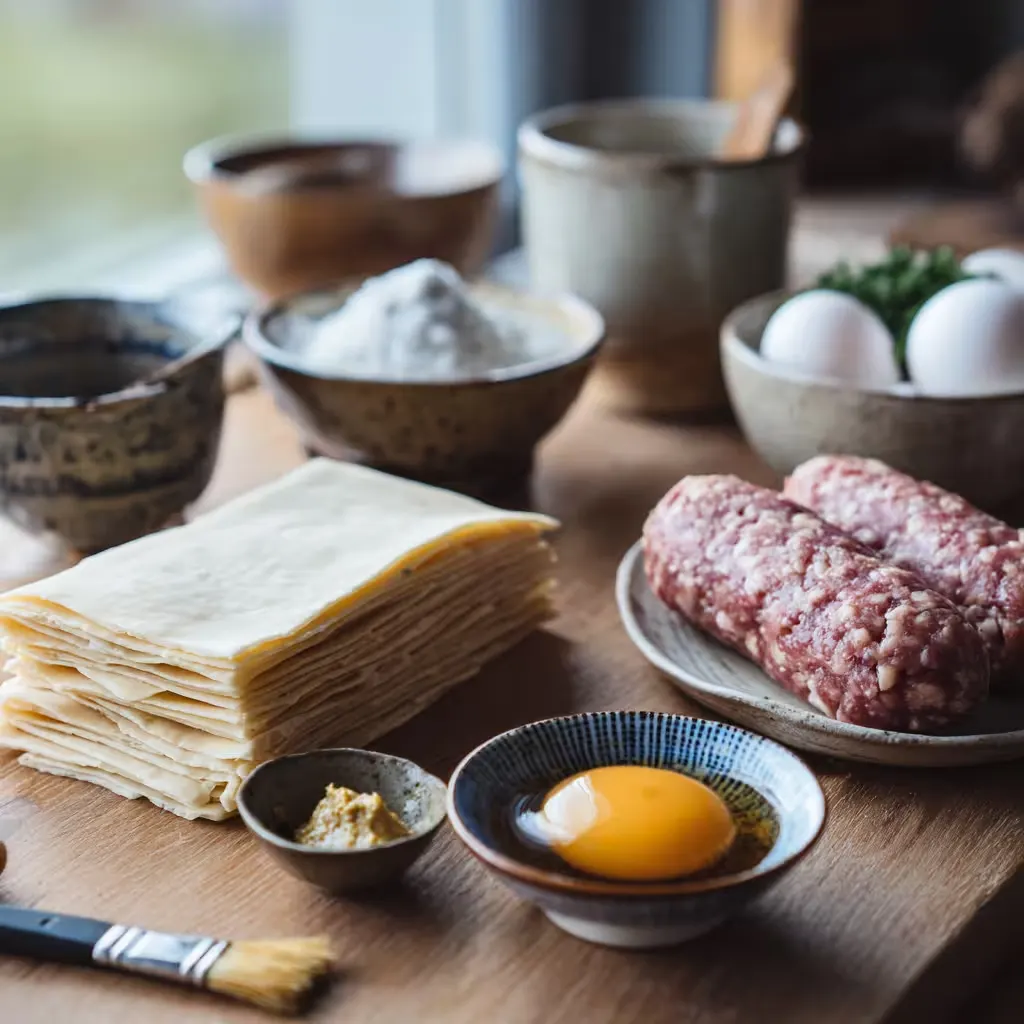When I first met my husband Mark, I had no idea what a sausage roll was—now I can’t imagine our weekends without them. Mark’s English Sausage Rolls are more than a snack; they’re a flaky, golden bite of home, packed with juicy pork sausage and wrapped in puff pastry. In this article, you’ll learn how to make them from scratch, avoid soggy bottoms, and freeze them like a pro. Whether it’s your first time baking them or you’re looking to perfect your roll, this guide will walk you through each step to mastering this comforting British favorite.
From Love to Lunch – A British Favorite in Our Kitchen
When I first tasted a sausage roll, I had no idea it would become such a cozy ritual in our home. Mark, my husband, grew up with sausage rolls as a staple in his English childhood. After we got married, he introduced me to his favorite version—simple, flaky, and loaded with perfectly seasoned pork. That first bite was unforgettable.
Now, Mark’s English Sausage Rolls are a weekend must in our kitchen. They’re the kind of dish that brings back memories and makes new ones all at once. We bake a batch, freeze half, and snack on the rest with a hot cup of tea or tomato chutney on the side. It’s comfort food at its finest—and yes, it’s incredibly easy to make.
For me, this recipe became more than just a dish—it was a way to connect with Mark’s roots. I’ve also shared similar traditions in recipes like my Creamy Chicken and Mushroom Pasta or my Puff Pastry Spinach Bites—because food bridges cultures, one flaky bite at a time.
As The Guardian explains, sausage rolls are a “national treasure” and a go-to comfort food across the UK.
Why Sausage Rolls Are a Beloved Staple in the UK
In the UK, sausage rolls aren’t just for parties—they’re everywhere. You’ll find them at bakeries, lunch counters, and even on breakfast plates. Their appeal? Portability, comfort, and that irresistible mix of crisp puff pastry and savory sausage meat.
A proper English sausage roll should be crisp, golden, and never soggy. The pastry must flake when bitten. It’s no wonder this recipe is a staple during holidays and casual gatherings. I keep a batch on hand in the freezer for guests, just like I do with Holiday Cheese Puff Twists.
Sausage rolls aren’t just snacks—they’re symbols of home, warmth, and shared joy.
Ingredients & Perfect Puff Pastry Tips

What Pastry and Meat Work Best
The key to great English sausage rolls is in the details—especially the pastry and the meat. For pastry, the classic choice is frozen puff pastry sheets, which deliver that signature golden flake. Just make sure they’re fully thawed but still cold when you work with them. Too warm, and the butter melts before baking. Too frozen, and it cracks.
As for meat, traditionalists use sausage meat, which is already seasoned. If you can’t find that, use ground pork and add your own seasoning: salt, black pepper, a pinch of nutmeg, and even dried thyme work beautifully. This adds depth and keeps the sausage rolls true to their British roots.
According to BBC Good Food, using chilled pastry and cold sausage helps keep your rolls crisp and golden.
In my kitchen, I’ve also made a few batches with seasoned turkey sausage from my Savory Turkey Breakfast Patties and even chicken sausage when I’m feeling adventurous. No matter the meat, the trick is keeping the filling juicy but not greasy—more on that in Part 3.
Flavor Upgrades: Mustard, Herbs & Add-Ins
To elevate the flavor, Dijon mustard brushed onto the pastry is a game-changer. It adds tang and sharpness that balances the richness of the meat. I also love folding in a bit of grated onion, sage, or even fennel seeds into the pork for extra flavor.
For those who love spice, try mixing in a pinch of cayenne or a dash of Worcestershire sauce—similar to what I do in my Mini Meatloaf Bites. These upgrades transform Mark’s English Sausage Rolls from simple to sensational, without straying too far from tradition.
Baking Success – Texture, Crispness & Soggy Bottom Fixes
Why Sausage Rolls Go Soggy (and How to Avoid It)
If your sausage rolls come out soggy, especially on the bottom, you’re not alone. The issue often comes down to excess moisture or improper baking techniques. Here’s how to fix it.
First, avoid using sausage meat with too much fat—it can leak and make the pastry wet. Instead, opt for lean pork or drain excess grease from raw sausage if it looks overly oily. You should also pat the pastry dry with a paper towel before assembly to remove condensation, especially if you’ve just thawed it.
A major tip? Never bake sausage rolls on parchment paper. Instead, use a nonstick baking sheet or a wire rack placed over a tray. This helps air circulate underneath and keeps the bottom crisp. I use this trick in my Crispy Baked Chicken Thighs recipe for similar results.
Lastly, bake at a high temperature—400°F (200°C)—to encourage a quick puff and seal in moisture before it escapes.
The Secret to Golden, Crispy Rolls Every Time
Crispy sausage rolls aren’t just about avoiding sogginess—they’re about the perfect finish. The secret? An egg wash. Lightly brushing the tops with beaten egg (and not the sides) ensures they puff up properly and turn a deep golden brown.
Another pro tip: make sure your sausage filling reaches an internal temp of 160°F (70°C). Undercooked sausage can release steam and soften the bottom crust. An instant-read thermometer is your best friend here.
For the final touch, sprinkle a bit of coarse sea salt or sesame seeds on top before baking—this adds texture and visual appeal, much like in my Cheddar Puff Pinwheels.
Freezing, Reheating, and Serving English Sausage Rolls
Can You Freeze Them Before or After Baking?
Absolutely! One of the best things about Mark’s English Sausage Rolls is how freezer-friendly they are. I almost always freeze half the batch before baking—they store beautifully and taste just as good later.
To freeze them raw, prepare the rolls completely, egg wash and all. Then place them on a parchment-lined tray in the freezer for about 1 hour, or until solid. Once frozen, transfer them to a sealed freezer bag. They’ll keep for up to 2 months.
When you’re ready to bake, there’s no need to thaw—just place them on a baking sheet and bake directly from frozen at 400°F (200°C) for about 25–30 minutes, checking for doneness. This technique is similar to how I handle frozen bakes like my Make-Ahead Breakfast Croissants.
You can also freeze them after baking, but note that the pastry may lose a bit of its crispness.
How to Serve Them (Hot vs Cold & When to Eat)
English sausage rolls are incredibly versatile when it comes to serving. They’re delicious hot right out of the oven, warm for brunch, or even cold for picnics or lunchboxes. In fact, in British lunch culture, they’re often eaten at room temperature, much like my Zucchini and Cheese Muffins.
For parties, slice them smaller and serve as bite-sized appetizers. For family dinners, pair them with a simple salad or mashed potatoes. They also make a perfect holiday brunch addition when served with hot tea, mustard, or a tangy chutney.
Whether hot or cold, sausage rolls remain a classic comfort—flaky, savory, and always satisfying.
The Spruce Eats recommends freezing sausage rolls before baking for better crispness and texture retention.

Frequently Asked Questions
What pastry is used for English sausage rolls?
Traditional English sausage rolls use puff pastry, known for its flaky, buttery layers. Frozen puff pastry sheets are a popular choice for convenience and consistent results. Just make sure they’re fully thawed and still cold before handling.
What meat is best for sausage rolls?
The classic meat is sausage meat made from seasoned pork. If unavailable, use ground pork with your own blend of herbs, salt, pepper, and spices. Lean pork works best to avoid excess grease, but some fat is essential for flavor and moisture.
Why are my sausage rolls soggy on the bottom?
Soggy bottoms usually come from too much moisture in the filling or underbaking. Make sure to use lean meat, pat your pastry dry, and bake on a nonstick sheet at a high temperature. You can also use a wire rack to improve airflow underneath.
Can you freeze English sausage rolls before or after baking?
Yes, both options work. Freezing before baking helps preserve texture—just bake from frozen when ready. You can also freeze them after baking, but they’ll lose a bit of crispness. Always store them in airtight containers or freezer bags.
Mark’s English Sausage Rolls are the kind of comfort food that connects generations—simple, flaky, and deeply satisfying. Whether you’re discovering them for the first time or honoring a family tradition, this recipe brings warmth to the table with every bite.
The beauty of sausage rolls is that they’re as adaptable as they are timeless. From freezer-friendly convenience to golden, crispy perfection, there’s a reason they’ve stayed a British classic for decades.
So preheat the oven, roll up some pastry, and bake a little piece of tradition today. One bite and you’ll understand why they’re always the first to disappear.
PrintMark’s English Sausage Rolls – The Classic British Comfort Bake
- Total Time: 35 mins
- Yield: 12 sausage rolls 1x
Description
These flaky, golden English sausage rolls are made with puff pastry and seasoned pork sausage, then baked to perfection. A British comfort classic you can make at home, freeze ahead, or serve hot or cold for any occasion.
Ingredients
1 (17.3 ounce) package frozen puff pastry sheets, thawed
¼ cup Dijon mustard
1 (16 ounce) package pork sausage meat or ground pork
1 large egg, beaten
Instructions
1. Preheat oven to 400°F (200°C). Line a baking sheet or use nonstick surface.
2. Unfold the puff pastry sheets. Cut each sheet into 6 squares to make 12 total.
3. Brush each square lightly with Dijon mustard.
4. Divide sausage into 12 equal portions and shape into small logs.
5. Place one log in the center of each pastry square.
6. Roll the pastry around the sausage and brush the edge with beaten egg to seal.
7. Place each roll seam-side down on the baking sheet.
8. Brush the tops with the remaining beaten egg.
9. Bake for 10 minutes. Check to ensure they aren’t burning.
10. Continue baking another 10 minutes until golden and puffed.
11. Check that internal temperature of the sausage reaches 160°F (70°C).
12. Let cool slightly. Serve warm or at room temperature.
Notes
You can freeze sausage rolls before or after baking. To freeze before baking, place assembled rolls on a tray in the freezer, then transfer to a freezer bag. Bake straight from frozen at 400°F for 25–30 minutes. To reduce sogginess, use lean pork and avoid wet fillings.
- Prep Time: 15 mins
- Cook Time: 20 mins
- Category: Appetizer
- Method: Baking
- Cuisine: British
Nutrition
- Serving Size: 1 sausage roll
- Calories: 360
- Sugar: 1g
- Sodium: 552mg
- Fat: 27g
- Saturated Fat: 6g
- Unsaturated Fat: 19g
- Trans Fat: 0g
- Carbohydrates: 20g
- Fiber: 1g
- Protein: 11g
- Cholesterol: 48mg
Keywords: Mark’s English sausage rolls, sausage roll recipe, British sausage rolls, puff pastry sausage rolls

